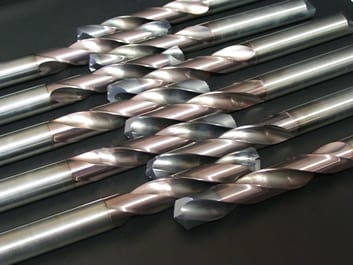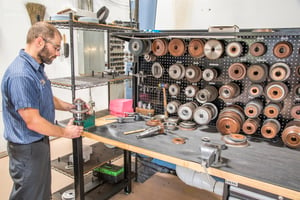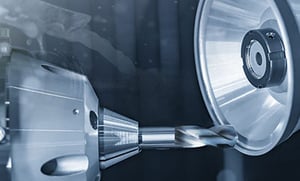Use of Custom Tooling Often Requires Expert Assistance

When people hear the word “custom,” they often think “expensive” or “unnecessary.” At Tru-Edge, we believe that custom tooling is essential to the success of numerous applications, so we’ve made a concerted effort to make it one of our strong points. As a result of that commitment to excellence, when someone asks for custom tooling, we always ask a series of questions to make certain that it’s the best solution for the application at-hand. Although custom tooling is more expensive than standard tooling in the short term, if used correctly it can be less expensive over the long term.
Put simply, for some applications, custom tooling can provide you with the best value for your purchasing dollars and help you meet your strategic objectives more effectively than standard tooling.
.jpg?width=204&name=TE_11-5-19_096%20(2).jpg)
In our world -- and perhaps yours too -- the term “customization” has multiple meanings. Customization can range from modifying existing designs to conceiving and manufacturing complex tooling that meets blueprint specs of applications in the many industries we serve. They include aerospace, automotive, food service, medical, mining, orthopedic instrument, tooling, die & mold, and woodworking.
Custom tooling’s advantages include combining multiple production steps into a single step, which decreases production time and reduces the probability of errors occurring at any given stage of the production process.
The custom tools we’ve designed include a variety of solid carbide end mills and drills used in machining a wide range of materials, including aluminum alloys, brass and bronze, low carbon and medium carbon steel, titanium alloys and high temp alloys with feeds and speeds best suited to the specific application.

The Custom Tooling Checklist
A custom tool can be designed for a single purpose, or for several uses. If you’re paying a premium for custom tooling, you have every right to expect that tooling to perform better than its standard counterpart. To help you make informed decisions, we’ve developed a half-dozen “if-then” statements – a 6-point checklist -- you can use when considering whether custom or standard tooling is best for your application.
If a custom tool reduces time, it could be worth the investment. Because such decisions are seldom black and white and instead involve many shades of gray, we can help you determine whether you’ll achieve the desired time savings with custom tooling.
If a custom tool reduces cost per part, it could be worth the investment. I say “could” because whether you achieve cost reduction depends on a host of variables too numerous to mention here. We can do back-of-the-envelope and detailed calculations alike with you to make sure you’re making the right decision.
If a custom tool increases accuracy, it could be worth the investment. For example, using a specially made step drill to maintain concentricity on a multi-diameter hole can eliminate the need for two separate drills and the separate operations needed to accomplish the step drill’s task, reducing the probability for errors and re-work. As with other benefits, the proof is in the numbers, and we’re more than willing to sharpen our pencil to help you achieve the best value for your procurement dollars.
If a custom tool increases your process reliability, it could be worth the investment. The reason is that, compared to standard tooling, custom tooling can offer more consistent tool life for a given application. That advantage makes tool changes more predictable and allows you to manage tool usage most effectively. This calculation requires us to have speeds and feeds before we can give you a definitive “yes” or “no.” If you’re reluctant to share that information with us, we can provide you with a written promise that we will keep your data confidential.
If a custom tool makes product handling easier, it could be worth the investment. If you need to drill holes of unusual diameters or with an exceptionally high finish quality, for example, tooling made especially for your application could be better than an off-the-shelf product. Again, we’ll need application-specific data, and perhaps a good old-fashioned eye test as well, to decide on a course of action.
If a custom tool reduces energy costs by requiring less horsepower or electricity to perform the desired function, as well as fewer tool changes and regrinds, it could be worth the investment.
As for which benefits are most important, it depends on your priorities. In our experience, reductions in time and cost per part, as well as increased accuracy, are what customers want most from their tooling. Those preferences have stayed constant through the years, and I expect them to remain so for the foreseeable future unless, for example, energy costs increase drastically.
If I sound evasive or tentative, it’s only because there are many variables involved in determining whether custom tooling or standard tooling makes the most sense for a given application. Thus, anyone who gives you simple answers or doesn’t provide you with a lot of backup to support their recommendation is probably trying to sell you a bill of goods.
For that reason, it’s advisable to involve a knowledgeable partner in your decision-making process to help ensure that you’re leaving no stone unturned because planning without having all the facts can create more problems than it solves. If I had a dollar for every time a customer – new or established – has called us to troubleshoot due to unforeseen circumstances, I could significantly increase our company’s commitment to supporting good works in the community.
.jpg?width=296&name=Social%20Post%20Photo%20of%20Tooling%20(October%202019).jpg)
Standard vs. Custom: The Ongoing Debate
The question of whether to use standard or custom tooling arises in many of our conversations with customers for two simple, interconnected reasons: Time is money and efficiency translates into profits.
To manufacture custom tooling that lives up to its promise, it’s necessary for us, as the tooling manufacturer, to conduct a comprehensive review of a customer’s application. By taking this step, we make certain that we can provide solutions to help customers meet their tooling-related challenges time and again.
Ideally, customers provide us with the following information so we can make recommendations and provide solutions based on actionable data:
- Type of material being worked on
- Drawings
- Machine data
- Explanation of how the component will be produced
Although this process can be time consuming for you – the tooling user – it’s a prime example of the old saying, “A stitch in time saves nine.” That’s because the more information we have at the beginning of the process, the more accurately we can quote the job, making life easier for you, your colleagues and your customers alike.
With the quick turnaround becoming the rule rather than the exception in all aspects of business, we can provide quotes promptly. That capability is attributable to improved technology, and to the fact that our breadth and depth of experience has enabled us to see so many applications that are similar or identical to a customer’s RFQ. As a result, we can rapidly apply our knowledge to any given situation knowing that our recommendations are sound because they are based on practical experience rather than on assumptions and theories.

Standard Tools Were Once Custom
It takes a concerted effort produce custom tooling, and it’s important to keep in mind that at one time much of today’s standard tooling likely started as custom solutions. What’s more, every standard tool for a given application came into being through trial and error, often over a period of years.
Without question, standard tooling allows you to begin a job sooner than custom tooling because standard tooling can be delivered quickly after you’ve chosen to purchase it. Such tooling also gives you a greater sense of predictability because it’s listed in machinists’ reference manuals along with charts related to dimensions and formulas, as well as engineering standards.
The one drawback to using standard tooling is that it may not be ideal for your specific material or setup, and that’s where we can be helpful. In fact, our ability to give good advice and help customers act on it is as solid as the tooling we manufacture.

Precision of Thought Leads to Best Use of Tooling
Although our customers have a deep understanding of their businesses, we’ve found that they sometimes need guidance with determining whether they need custom tooling, and what specific type of tooling is best for their application. That’s because they often “don’t know what they don’t know.” If that description fits you, rest assured that you’re not alone.
Since we opened our doors in 1996 our experience has led us to develop several profiles of custom tool users:
- Customers who have no idea of what they need but understand intuitively or based on shop floor experience that the tooling required for a given application goes beyond the capabilities of standard tooling. With few exceptions, these customers provide us with application information and appreciate the suggestions we offer based on their drawings or samples.
- Customers who have a general idea about their tooling needs. They provide us with drawings, samples, rough tool designs, and possibly machine approaches that we can consider before offering them our recommendations.
- Customers who have been using standard tooling successfully and have never considered custom tooling for a given application until one of their customers suggests it or they get ideas from reading articles in trade journals or attending trade shows.
- Customers who want someone to fabricate tooling that they know is best for their respective applications. Sometimes, these customers want help with confirming the correctness of the specifications, but most of the time we’re fulfilling an order without offering as much consultation as we’re able to provide, and that’s fine if the customer is pleased with our work, as well as other aspects of the relationship.
Regardless of where customers might fit in that range of experiences or preferences described, we make a concerted effort to meet them on their own terms so we can provide them with the right tooling quickly and efficiently to help them meet their production goals and achieve other benchmarks.
As a bonus, we often enable our customers to exceed expectations related to productivity and quality, which in turn helps them strengthen relationships with their customers.
When an automotive industry customer of ours needed solid carbide end mills to make crankshaft cases, we calculated tool life based on data the customer provided and verified it by observing the customer’s production line. As it turned out, the customer got 20% more wear out of each end mill than projected and increased throughput by more than 30%. As a result of those improvement, our customer received more orders from its customer and was able to accelerate the purchasing cycle for a new machining center. Those types of results are a big part of what keeps me and the rest of our team passionate about what we do.

Knowledge of Machines
One of our many areas of expertise that can be particularly helpful to customers – and something that differentiates us from other tooling manufacturers -- is our comprehensive knowledge of machines on which your tooling will be used. That’s because we’ve dealt with a wide range of customers who use as many different types of machines as the day is long.
By knowing what kind of a machine – or machines – you’re using for applications requiring our assistance, the higher the probability of our tooling meeting your specifications and exceeding expectations related to quality, productivity, throughput and other factors that can have an impact on profitability.
Specifically, if we know the type of machine you’re using, we can help you determine capacity as well as the best materials to use in your tooling so you can maximize the life span of each tool and obtain maximum value from us.
By having information about your machines’ capacities and performance characteristics, we can also help you develop and implement a production strategy that is mutually beneficial to you and your customers. Such plans can also help you maximize uptime and minimize scrap, as well as determine coating or regrinding intervals that help you optimize productivity.
Our willingness to take the extra time to understand the abilities and tendencies of your machines can go a long way to helping you develop or strengthen a large base of customers who are loyal to you and not merely satisfied.
On too many occasions, I’ve seen customers squander opportunities or otherwise fail to take advantage of opportunities to improve quality, productivity, throughput and other measures of a successful operation because they wouldn’t or couldn’t provide data to make informed decisions about tooling and made purchasing decisions which did not serve them well.
By sharing a few insights from being in the tooling business for more than 25 years, I hope you’re better equipped to determine when it’s best to use custom tooling, and when expertise from an experienced partner can be useful.
 Because tool selection involves many factors, you should know that my team and I are always prepared to roll up our sleeves, learn about your objectives and equipment, provide recommendations and turn those suggestions into actions that help you succeed.
Because tool selection involves many factors, you should know that my team and I are always prepared to roll up our sleeves, learn about your objectives and equipment, provide recommendations and turn those suggestions into actions that help you succeed.
Tell us about a tooling-related challenge you’ve faced recently, and we’ll let you know how to meet it most effectively.

-feature.jpg)
